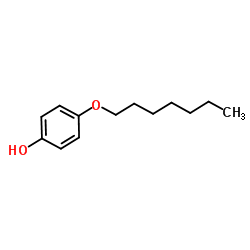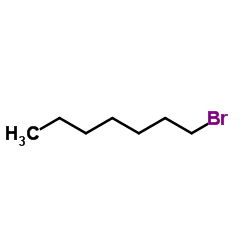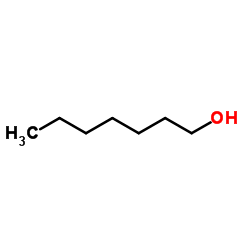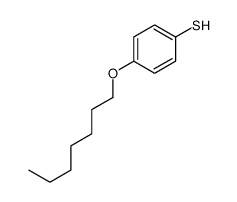4-(Heptyloxy)phenol

4-(Heptyloxy)phenol structure
|
Common Name | 4-(Heptyloxy)phenol | ||
|---|---|---|---|---|
| CAS Number | 13037-86-0 | Molecular Weight | 208.297 | |
| Density | 1.0±0.1 g/cm3 | Boiling Point | 325.3±15.0 °C at 760 mmHg | |
| Molecular Formula | C13H20O2 | Melting Point | 60-63 °C(lit.) | |
| MSDS | Chinese USA | Flash Point | 144.8±5.3 °C | |
| Symbol |

GHS07 |
Signal Word | Warning | |
Use of 4-(Heptyloxy)phenol4-Heptyloxyphenol (p-(heptyloxy)phenol) has antibacterial activity agaisnt P. gingivalis, S. artemidis, Str. sobrinus (MIC: 0.10, 0.21, 0.14 mM)[1]. |
| Name | 4-Heptyloxyphenol |
|---|---|
| Synonym | More Synonyms |
| Description | 4-Heptyloxyphenol (p-(heptyloxy)phenol) has antibacterial activity agaisnt P. gingivalis, S. artemidis, Str. sobrinus (MIC: 0.10, 0.21, 0.14 mM)[1]. |
|---|---|
| Related Catalog | |
| References |
| Density | 1.0±0.1 g/cm3 |
|---|---|
| Boiling Point | 325.3±15.0 °C at 760 mmHg |
| Melting Point | 60-63 °C(lit.) |
| Molecular Formula | C13H20O2 |
| Molecular Weight | 208.297 |
| Flash Point | 144.8±5.3 °C |
| Exact Mass | 208.146332 |
| PSA | 29.46000 |
| LogP | 4.50 |
| Vapour Pressure | 0.0±0.7 mmHg at 25°C |
| Index of Refraction | 1.506 |
| Storage condition | Store at +4°C |
CHEMICAL IDENTIFICATION
HEALTH HAZARD DATAACUTE TOXICITY DATA
|
| Symbol |

GHS07 |
|---|---|
| Signal Word | Warning |
| Hazard Statements | H315-H319-H335 |
| Precautionary Statements | P261-P305 + P351 + P338 |
| Personal Protective Equipment | dust mask type N95 (US);Eyeshields;Gloves |
| Hazard Codes | Xi:Irritant; |
| Risk Phrases | R36/37/38 |
| Safety Phrases | S26-S37/39 |
| RIDADR | NONH for all modes of transport |
| WGK Germany | 3 |
| RTECS | SL4860000 |
| HS Code | 2909500000 |
|
~38% 
4-(Heptyloxy)phenol CAS#:13037-86-0 |
| Literature: Chin, E.; Goodby, J. W. Molecular Crystals and Liquid Crystals (1969-1991), 1986 , vol. 141, p. 311 - 320 |
|
~% 
4-(Heptyloxy)phenol CAS#:13037-86-0 |
| Literature: US1883952 , ; Journal of the American Chemical Society, , vol. 54, p. 298,303, 304 |
|
~8% 
4-(Heptyloxy)phenol CAS#:13037-86-0 |
| Literature: Rybin, A. G.; Orlov, A. V.; Zil'berman, E. N.; Barskova, M. Z. Journal of Organic Chemistry USSR (English Translation), 1991 , vol. 27, # 9.1 p. 1609 - 1611 Zhurnal Organicheskoi Khimii, 1991 , vol. 27, # 9 p. 1828 - 1831 |
|
~% 
4-(Heptyloxy)phenol CAS#:13037-86-0 |
| Literature: Molecular crystals and liquid crystals, , vol. 88, # 1-4 p. 81 - 86 |
| HS Code | 2909500000 |
|---|---|
| Summary | 2909500000 ether-phenols, ether-alcohol-phenols and their halogenated, sulphonated, nitrated or nitrosated derivatives VAT:17.0% Tax rebate rate:9.0% Supervision conditions:none MFN tariff:5.5% General tariff:30.0% |
|
Impact of induced fit on ligand binding to the androgen receptor: a multidimensional QSAR study to predict endocrine-disrupting effects of environmental chemicals.
J. Med. Chem. 48 , 5666-74, (2005) We investigated the influence of induced fit of the androgen receptor binding pocket on free energies of ligand binding. On the basis of a novel alignment procedure using flexible docking, molecular d... |
|
|
The expression of Steroidogenic Factor-1 and its role in bovine steroidogenic ovarian cells during the estrus cycle and first trimester of pregnancy.
Anim. Reprod. Sci. , doi:10.1016/j.anireprosci.2013.01.008, (2013) The orphan receptor Steroidogenic Factor-1 (SF-1, NR5A1), a member of the nuclear receptor superfamily, is present in fetal and adult steroidogenic tissues and also participates in the regulation of o... |
|
|
The orphan nuclear receptor SF-1 is involved in the effect of PCBs, DDT, and DDE on the secretion of steroid hormones and oxytocin from bovine luteal cells during the estrous cycle in vitro.
Theriogenology 81(7) , 877-86, (2014) The orphan receptor steroidogenic factor-1 (SF-1) is involved in the regulation of ovarian steroidogenesis in cows. It is hypothesized that estrogen-like chlorinated compounds might affect SF-1, and t... |
| 4-(Heptyloxy)benzolol |
| 4-heptoxyphenol |
| 4-(Heptyloxy)phenol |
| MFCD00002338 |
| Hydroquinone Monoheptyl Ether |
| Phenol, 4-(heptyloxy)- |
| EINECS 206-736-0 |
| 4-(Heptyloxy)phenol (9CI) |



 CAS#:62554-43-2
CAS#:62554-43-2 CAS#:62716-69-2
CAS#:62716-69-2 CAS#:38454-39-6
CAS#:38454-39-6